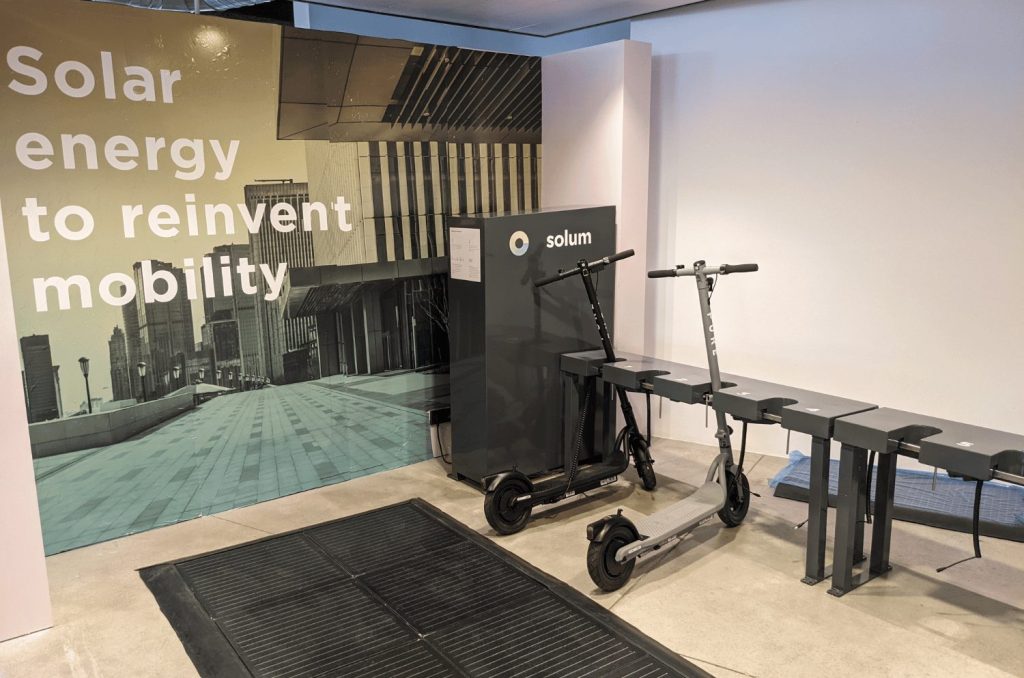In the world of urban mobility, electric scooters are rapidly gaining popularity. With this growing demand, the need for infrastructures like lockers for electric scooters or solar charging stations has emerged to facilitate their use and charging.
Have you ever wondered about the differences between charging your scooter at a solar charging point versus lockers for electric scooters? Keep reading this post as we explain the key differences.
How Does a Solar Charging Station for Scooters Work?
As its name suggests, the solar charger uses and harnesses sunlight to generate electrical energy. Solar panels capture sunlight to charge scooters in a simple and efficient way. What about overcharging? Voltage and current are regulated by a charge controller before transferring to the scooter.
These panels are part of the Helios charging stations developed by Solum. It’s a 100% sustainable way to charge your scooter, serving both for parking and recharging. Through our Arena flooring, which features photovoltaic cells integrated into tiles, solar energy can be generated. This flooring is pedestrian-friendly, non-slip, and has self-healing properties for superficial damage.

What Are the Advantages of a Solar Charging Station for Scooters?
Here are some benefits of solar energy and solar chargers:
- Renewable: It comes from an inexhaustible source, the sun.
- Environmentally friendly: It has less impact on the environment.
- Reduces fossil fuel usage: Less dependency on non-renewable resources.
- Economical: While the initial investment is high, it becomes cost-effective over time as it’s unaffected by electricity price increases.
How Do Lockers for Electric Scooters Work?
Lockers for electric scooters are a parking system that provides a closed space for scooters, as their name implies. Additionally, some lockers for electric scooters come equipped with added security measures, such as electronic locks or surveillance systems, to protect scooters from theft or damage. Their function is similar to that of a parking station for scooters, but lockers differ in that they are fully enclosed, while parking stations are partially open.
One major advantage is the security they provide, as they use password systems. Inside, besides storing a folded scooter, users can leave other items and even charge their mobile phones.

Lockers vs. Parking for Scooters
Both lockers and parking areas for electric scooters are designated spaces for securely storing and charging these personal mobility devices.
Similarities Between Lockers and Parking for Scooters:
The biggest advantage of both solutions lies in the security they offer. At Solum, we ensure protection through smart locks to prevent theft or damage to electric scooters. This focus on security provides peace of mind to users, ensuring their devices are safe when not in use.
Both lockers and parking spaces for Solum scooters operate through mobile apps, enabling convenient parking management. From our app, users can access features like checking station availability across the city and reserving parking spaces in advance.
This planning capability ensures there is always a safe and convenient place to leave electric scooters, offering users both comfort and security
Differences Between Lockers and Parking for Scooters:
A key difference between lockers for electric scooters and Solum parking stations lies in the charging method used. While lockers typically use electric charging systems, our scooter parking stations integrate solar charging, eliminating reliance on non-renewable energy sources.
This distinction offers a more sustainable and environmentally friendly solution, reducing the carbon footprint associated with charging electric scooters, as mentioned earlier in this article.
At Solum, we’ve developed the Helios solar station to promote sustainable mobility and charging. These stations can be found at various city locations, shopping centers, and even across different European cities.
Helios offers all the conveniences of lockers for electric scooters, with the added sustainability benefit of solar charging.
If you want to learn more about sustainable charging solutions, enjoy staying informed, and frequently read articles about electric scooters, e-bikes, energy-saving tips, and related topics, this is the blog for you.
We invite you to subscribe to stay updated on the latest news and tips for a more sustainable life. Don’t hesitate to contact us!








